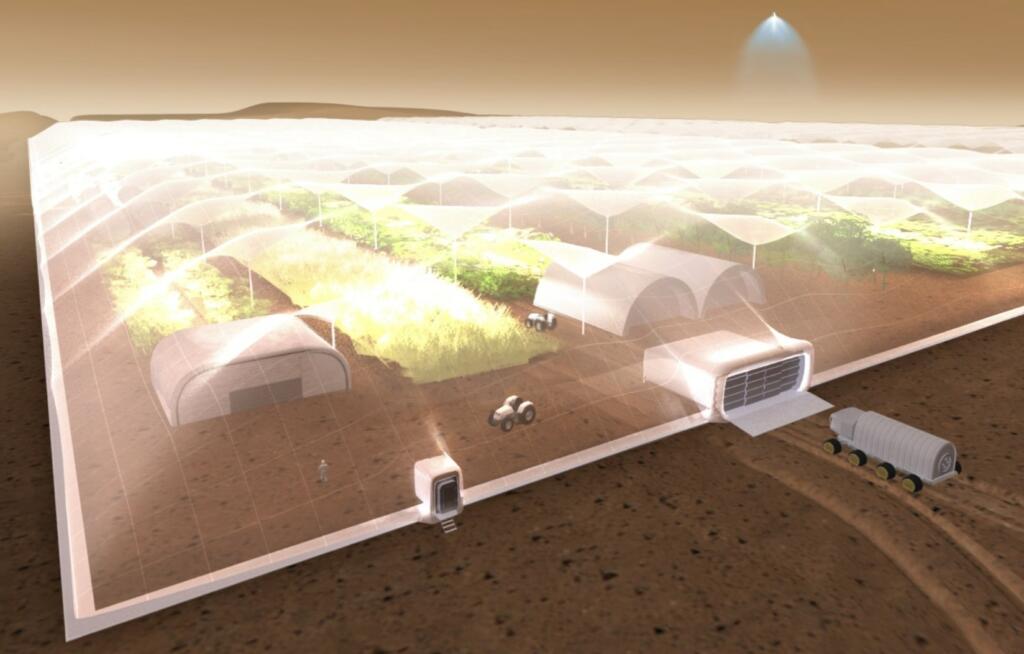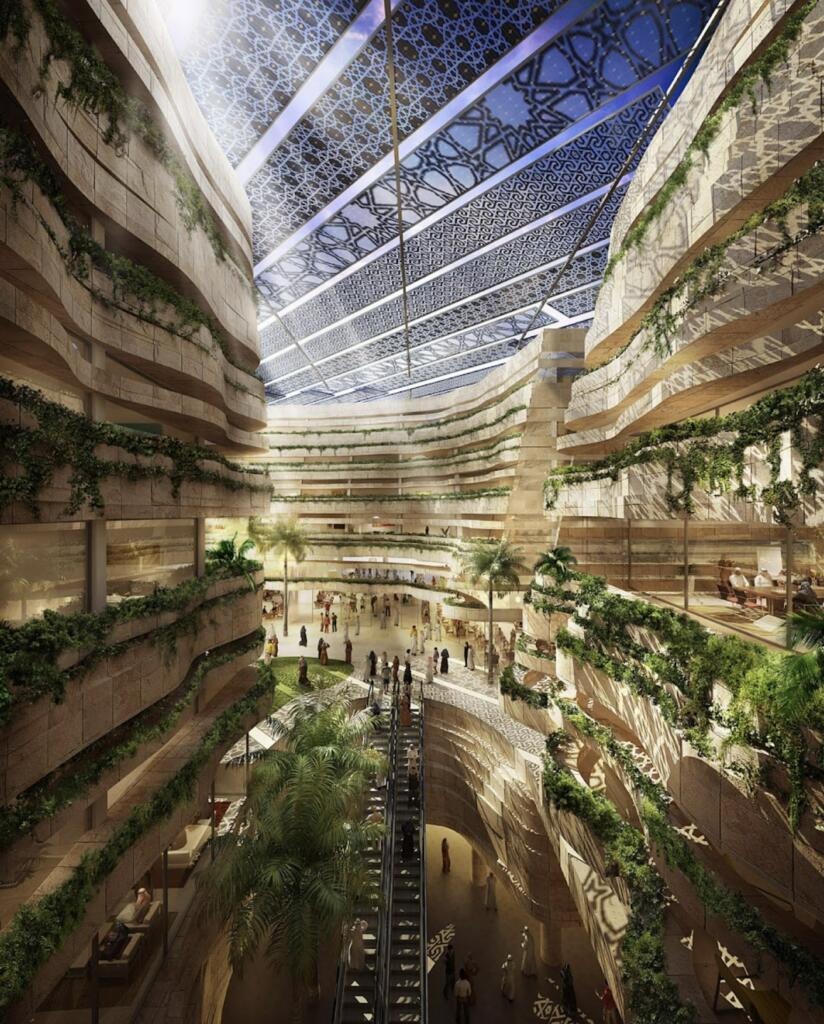Paraterraforming (or World House Design) is a subset of Terraforming where we build huge structures which may cover a large fraction of a world’s surface. A key advantage is that it is usually much faster than terraforming but it can enable larger habitable areas than just making capsules or buildings.
LAVA architects and others have looked at doming canyons for Masdar City but it would also be applicable to Mars as a path to step by step terraforming of Mars.



Paraterraforming Mars
Paraterraforming essentially means making more and more greenhouses extending from settlements. If extended throughout the surface of Mars these greenhouses become what’s referred to a worldhouse.
The big advantage is that the paraterrraforming approach could provide Earth-like environments immediately. Indeed, it seems unreasonable to expect that settlers would wait thousands of years until the entire planet had been terraformed before wanting to have some Earth-like, natural environments to walk around in. So paraterraforming will be done and with automation, probably done on a large scale.
Marking Earth-like Air
The Martian atmosphere is about 95% CO2, 2% nitrogen, and 2% argon. Both nitrogen and argon are buffer gasses of great use for breathing and preventing fires on an environment with oxygen. So, by converting the CO2 into O2 (with algae or non-biologically) and separating out the N and Ar, one could produce breathable air with the following characteristics:
– 1/2 atmospheres of pressure
– 20% oxygen
– 40% nitrogen
– 40% argon.
The entire surface of Mars could eventually be transformed to this sort of air with a ceiling height of about 50 feet. But well before that, one could produce air within domes over numerous, very large settlements. In other words, it is possible to produce large Earth-like environments larger than what the settlers would need and to provide those environments as needed as the population grows.
Full Up Terraforming takes centuries to Millenia.
Super Greenhouse Gases
Factories are built to make a lot of super greenhouse gasses. This will heat up the Martian atmosphere and thicken the atmosphere with more CO2. The best near term goal would be to trigger enough heat to make the frozen CO2 in the Mars poles to sublimate. This could get 2-8 times the thickness of the atmosphere which would still be only about 10% of the thickness at the top of Mount Everest on Earth. The Martian atmosphere has a pressure of 6.518 millibars (0.095 psi) at ground level. This is 0.6% of Earth’s atmospheric pressure, which is 1013.5 millibars (14.7 psi).
The main challenges of this approach are three.
1) There’s some doubt as to whether there is enough CO2 bound up in the Martian dirt to adequately warm the planet.
2) The end result is an atmosphere which is not breathable by humans unless further processed. But there would
3) The time needed to complete this process is typically measured in the thousands of years.
Chris McCay describes how to terraform Mars within about one years of starting. Chris has determined that using supergreenhouse gases like C3F8 (Octafluoropropane) would warm up the atmosphere by about 40 degrees celsius and increase the pressure many times. This would enable Mars to grow plants and trees.
The terraforming analogy is that of moving down a mountain. Terraforming will reduce the coldness and increase the air pressure.


Brian Wang is a Futurist Thought Leader and a popular Science blogger with 1 million readers per month. His blog Nextbigfuture.com is ranked #1 Science News Blog. It covers many disruptive technology and trends including Space, Robotics, Artificial Intelligence, Medicine, Anti-aging Biotechnology, and Nanotechnology.
Known for identifying cutting edge technologies, he is currently a Co-Founder of a startup and fundraiser for high potential early-stage companies. He is the Head of Research for Allocations for deep technology investments and an Angel Investor at Space Angels.
A frequent speaker at corporations, he has been a TEDx speaker, a Singularity University speaker and guest at numerous interviews for radio and podcasts. He is open to public speaking and advising engagements.


Unmentioned is the issue of sufficient gravity to retain the atmosphere. Martian gravity is about 1/3 terrestrial gravity. This suggests way too much ease in letting that hard won atmosphere literally float away.
Another concern is pressure from solar radiation, but it sounds like this is not a large enough concern over the course of 100 years.
Hi Brian
Quote: “within about one years of starting”? Did you mean “within about one hundred years”?
Only 5t/m2 Pressure on the dome, easy-peasy. And what about cosmic radiation?
Some disturbed person will depressurize the habitat. Looks cool though.
Nope, they will have an AI watching them 24/7
Some disturbed person will depressurize the habitat.
Obviously, you’re going to compartmentalize things even if you cover the entire planet.
So, only 30 dead per psychopath
Roughly a school mass shooting or two.
Half-normal air pressure with 20% oxygen means the whole sorry lot will be systemically hypoxic, like the permanent dwellers of 3000m+ areas on Terra, with their survival-optimised physiology. The point is not the wrong air mix, which can be made correctly, but the people who saying such things without knowing what they mean. The best way to sabotage Mars enterprise is incompetence blatantly sold as expertise, with unlimited consequences, all of them bad.
Yes, it sounds a bit far fetched. However, half normal atmospheric pressure is 500 mb, full atmospheric is 1000 mb or 14.7 psi. 500 mb corresponds to about 18,000 ft.
This would be difficult for people born near sea level, but … people from the Andean population live at these attitudes. Another group to draw from would be Tibetans, both groups have genetic adaptations. So recruiting indigenous peoples would be a feasible proposition.
I suspect that 0.2bar of oxygen and 0.3bar of nitrogen would be better composition. It would translate to 40% O2 60% N2 and probably wouldn’t be as tiring and livable for all humans. Increased fire hazard would be probably worth it.
Much more fun could be had in Venus airship. Diving can be done to 50m if I recall, so such airship would have 0.2bar O2 and up to 5.8bar of He and N2 (So ship can get more buoyancy in denser and closer to ground parts of atmosphere)
Good power source will be very important for initial cities. Mars’ solar irradiance (W/m2) is around 43% of Earth’s. That is less and the planet is much colder. There are almost no clouds so the solar will be more reliable. I think nuclear energy is the best solution, with good backup. Partial underground cities will use less energy for heating. Tesla bots will be there before humans and prepare a base to mitigate the risk.